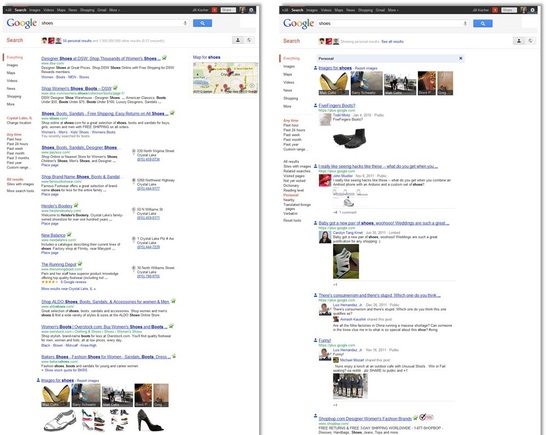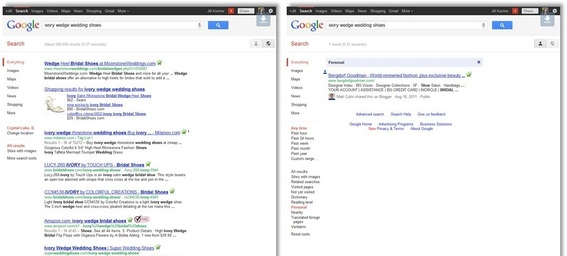As search and social become ever more entwined in Google’s and Bing’s algorithms and search results, search engine optimizers cannot afford to turn a blind eye to social media. Bing incorporates Facebook data into its search results. Google has taken another big step with the introduction of Search, Plus Your World. Last week we explored the social media impact of Search, Plus Your World, in “Google Integrates Google+ in Search Results.” In this article, I’ll focus on the search-engine-optimization impact of this new feature.
Visibility in Search Results
The biggest impact SPYW has on SEO is the visual and personal nature of the results it returns. Compare these two search result sets for a very common search phrase: “shoes.”

On the left is Google’s typical search results page for a search for “shoes.” On the right is Google’s SPYW result page for the same query.
On the left is the typical Google search result set with a couple of high ranking brands, some local results and image results. On the right is my SPYW result set, made up entirely of what my circle of friends shared on Google+. It contains everything from a fabulously geeky post about modifying shoes with Android to a gleeful post about shopping for shoes to wear to a summer wedding.
The SPYW results are far more visually appealing, with the many images and mug shots of faces I’ll recognize because they’re in my Google+ Circles. It’s also much more entertaining than the straight result set because it’s full of opinions and some just weird stuff. So if I’m in the mood to be entertained and see what people I know think about a topic, SPYW is great.
But what if I want to buy shoes for my wedding in four months? This SPYW result set is not in the least bit useful to me. Even if I narrow my search query to “ivory wedge wedding shoes,” the SPYW results are still not useful in my online purchase quest.

More specific search phrases — such as “ivory wedge wedding shoes” — can result in few to no SPYW results, as shown on the right.
It would be easy to jump to the conclusion that SPYW is not relevant to ecommerce SEO. But that would be a premise based on a couple of things that are specifically true about my interactions on Google+, which determines the deeply personalized results I’ll receive in SPYW. First, nearly all my Google+ friends are obsessed with SEO or Android or technology in general, not shoes. Second, I’ve not been able to coax most of my Facebook and Twitter friends over to Google+. The everyday girly interests we share are still occurring on Facebook rather than Google+. Third, I haven’t +1’d a single shoe brand. All of these factors — specific to my interactions in Google+ — limit Google’s SPYW usefulness in an ecommerce query for “shoes” or “ivory wedge wedding shoes.”
This dive into the minutia of my personal Google+ activity is meant to illustrate a larger point. Just as my Google+ activity is specific to the people I know, their willingness to join Google+, and their desire to share certain things and not other things on Google+, so is every other individual’s Google+ activity out there. This is personalization at the most individual level, and represents a completely different SPYW experience for each of those people.
Ecommerce Sites Can Benefit from SPYW
So how does an ecommerce site take advantage of the SPYW opportunity for more visibility in search results? Contributor Paul Chaney got the ball rolling in his article last week with the following action items.
- If you don’t already have a Google+ business page, set one up. Paul’s previous article on the topic, “How to Create a Google+ Business Page,” should help.
- Share content with Google+ regularly. Zappos’ Google+ page is a good model to follow. The company shares product images with links to the online catalog, videos, status updates, news about issues related to the company, and even personal anecdotes.
- Build your network. It does no good to post content if you don’t have a group of followers to share it with. One way to do this is by adding a Google+ badge to your website that links to your Google+ page. In addition, add the +1 button to product pages, which enables people to recommend your products and services. Once people add your page to their Circles, add them back.
These are great tips. To these I’ll add a fourth step: Make it easy for fans to +1 content on your ecommerce site. I wrote about this previously, in “Using Social Buttons to Enhance Search Engine Optimization.”
Paul is right. Zappos does do an excellent job populating its Google+ stream with content. It even has some fan comments, re-shares and +1s of its posts, each of which shares the content to a wider audience on Google+ and in search results. But on the Zappos site itself, there’s no mention of its Google+ account, no buttons to +1 Zappos.com, and no buttons at the product level to +1 or share to Google+. You can email, Facebook or tweet any product you choose, but Zappos hasn’t yet made it easy to +1 and share to Google+. The same goes for Shoes.com, another major ecommerce shoe site with a strong Google+ page but poor onsite integration with Google+.
Summary
Remember, arming an ecommerce site with sharing buttons is like partially outsourcing social media and SEO success to consumers. A marketing team can only share so much content on its own, and that content tends to sound like, well, marketing. But empowering consumers to share content in their languages with their enthusiasm goes a lot farther both in terms of the sheer numbers of sharing posts and the power of that person’s endorsement with their friends and potentially their friends’ friends on Google+. It now affects Google’s Search, Plus Your World results.





